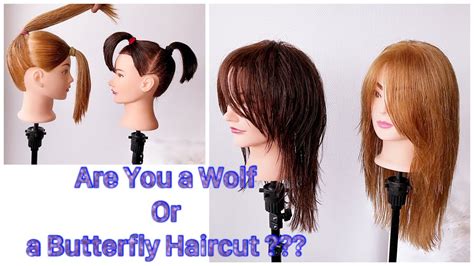Introduction

The wolf cut and butterfly cut are two trendy hairstyles that have gained immense popularity in recent years. Both haircuts feature layered, shaggy styles, but they offer distinct differences in appearance and suitability. This article provides a comprehensive comparison of the wolf cut and butterfly cut, exploring their features, benefits, and suitability for different face shapes and hair types.
Wolf Cut
Definition: A wolf cut is characterized by short, choppy layers on top that gradually blend into longer, feathered layers below. The result is a voluminous, textured style with a “wolf-like” appearance.
Key Features:
- Short, choppy layers on top
- Gradual transition to longer layers
- Voluminous, textured finish
- Edgy, effortless look
Benefits:
- Adds volume and texture to hair
- Frames the face and highlights cheekbones
- Versatile style that can be customized to suit different face shapes
- Low maintenance and easy to style
Suitability:
- Ideal for oval, round, and square face shapes
- Suitable for all hair types, including fine, medium, and thick hair
- Not recommended for hair that is prone to breakage or split ends
Butterfly Cut
Definition: A butterfly cut is a layered haircut that resembles the shape of a butterfly’s wings. It features short, choppy layers around the face that frame the cheekbones and chin. The layers gradually lengthen towards the back, creating a voluminous, A-line silhouette.
Key Features:
- Short, choppy layers around the face
- Gradual lengthening of layers towards the back
- Voluminous, A-line silhouette
- Feminine, ethereal look
Benefits:
- Creates a soft, feminine frame around the face
- Elongates the neck and makes the face appear thinner
- Adds volume and movement to hair
- Versatile style that can be worn with or without bangs
Suitability:
- Ideal for heart, oval, and diamond face shapes
- Suitable for fine to medium hair types
- Not recommended for thick or coarse hair
Comparison Table
| Feature | Wolf Cut | Butterfly Cut |
|---|---|---|
| Layer Length | Short on top, long below | Short around the face, long towards the back |
| Silhouette | Textured, layered | Voluminous, A-line |
| Appearance | Edgy, effortless | Feminine, ethereal |
| Suitability | Oval, round, square | Heart, oval, diamond |
| Ideal Hair Type | All | Fine to medium |
Key Differences
The primary difference between the wolf cut and butterfly cut lies in the length and placement of the layers. The wolf cut features short, choppy layers on top that gradually blend into longer layers below, creating a voluminous, textured appearance. In contrast, the butterfly cut has short, choppy layers around the face that frame the cheekbones and chin, with the layers gradually lengthening towards the back to create a voluminous, A-line silhouette.
Another key difference is the suitability for different face shapes. The wolf cut is versatile and can flatter oval, round, and square face shapes. The butterfly cut, on the other hand, is best suited for heart, oval, and diamond face shapes.
Which Cut is Right for You?
The best choice between a wolf cut and butterfly cut depends on your individual style, face shape, and hair type. If you prefer an edgy, effortless style that adds volume and texture to your hair, a wolf cut is a great option. If you want a feminine, ethereal look that elongates the neck and frames the face, a butterfly cut is a suitable choice.
Tips for Styling
- Wolf Cut: Use a volumizing shampoo and conditioner to enhance texture. Blow dry your hair upside down to create lift at the roots. Finish with a texturizing spray or mousse to define layers.
- Butterfly Cut: Apply a smoothing serum to tame flyaways and create a sleek finish. Blow dry your hair with a round brush to create volume and shape. Use a hairspray to hold the style in place.
Conclusion
Both the wolf cut and butterfly cut are fashionable and versatile hairstyles that can flatter a wide range of face shapes and hair types. By understanding the key differences between the two cuts, you can make an informed decision that best suits your personal style and beauty aspirations.
